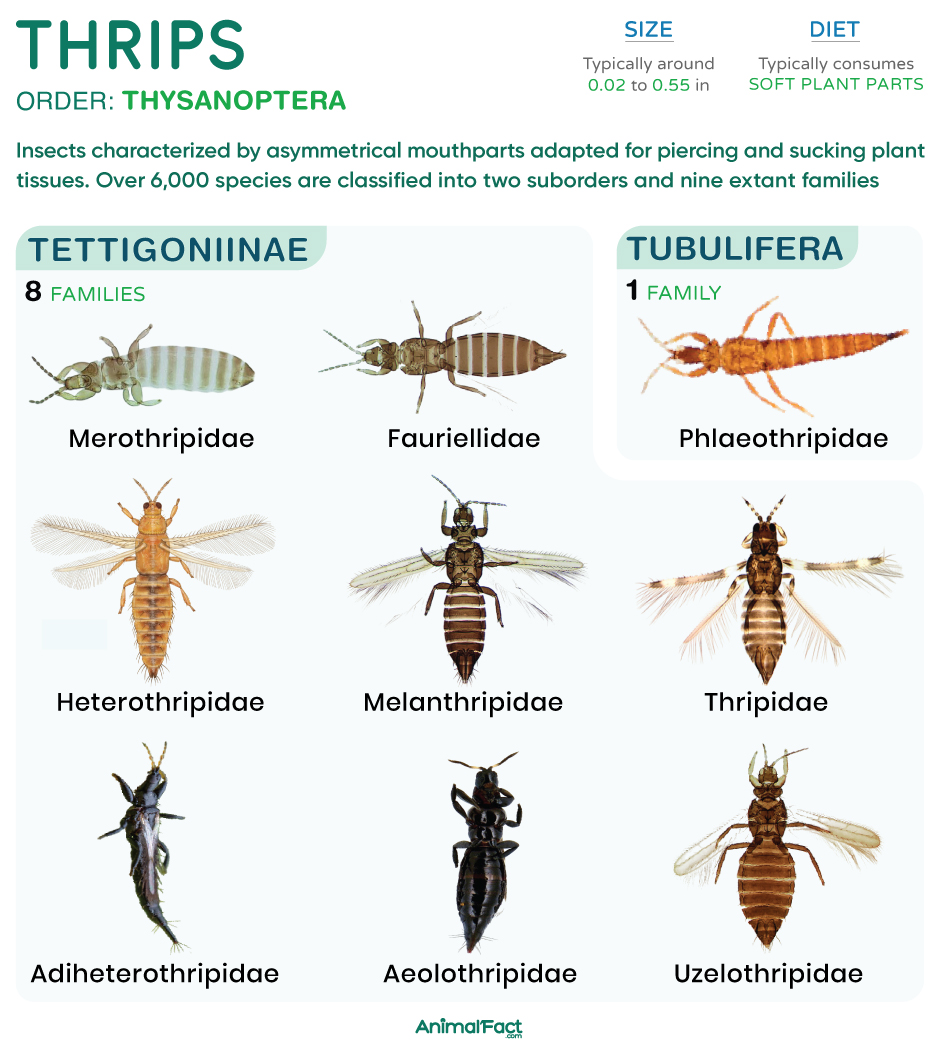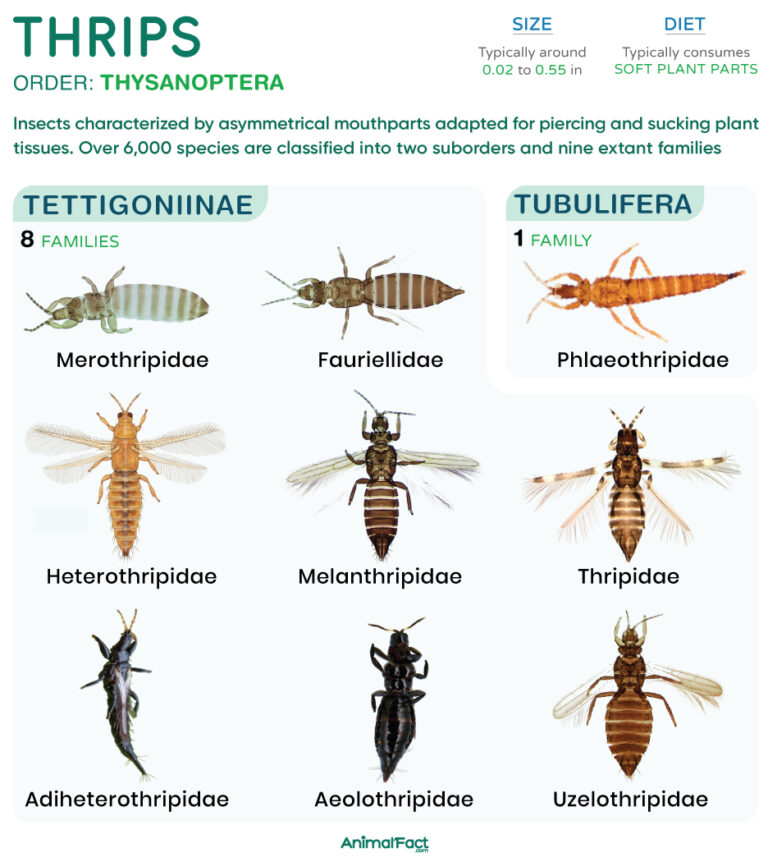


Thrips are insects that constitute the order Thysanoptera. They are characterized by asymmetrical mouthparts adapted for piercing and sucking plant tissues. Their winged forms possess notable, feather-like, fringed wings.

Although hemimetabolous, these insects have a distinct developmental process in which eggs hatch into two feeding nymphal stages, followed by two non-feeding prepupal and pupal stages, before maturing into adults.
Found worldwide except in extreme polar regions, these insects inhabit leaves, flowers, buds, and occasionally soil or leaf litter. As feeders of plant sap, thrips inflict major damage on commercially important crops and ornamental plants. Moreover, they serve as vectors for over 20 viruses (particularly Topsoviruses), causing plant diseases.
These insects range in size from 0.02 to 0.55 in (0.5 to 14 mm), with most species measuring about 0.03 in (1 mm).
Thrips are characterized by a cigar-shaped, elongated, bilaterally symmetrical body, divided into three broad segments: head, thorax, and abdomen.
The head is directed downwards (hypognathous) in most species, bearing a pair of short antennae (usually 4 to 9 segments), a pair of compound eyes, three simple eyes (ocelli), and specialized, asymmetrical mouthparts. The right mandible is reduced, vestigial, or completely absent in some species, whereas the left mandible is functional and helps cut into plant tissues.
The thoracic region is divided into the pro-, meso, and metathorax, with each subsegment bearing a pair of legs. The legs are short and end in tarsal segments bearing a bladder-like structure (arolium), which helps them adhere to surfaces.
The mesothorax and metathorax bear narrow, strap-like wings in winged forms. These wings are characteristically fringed with long hairs. However, many species are wingless, too. For instance, in the grass thrips (Anaphothrips obscurus), about 90% of the population in spring are winged, while in late summer, wingless forms may constitute around 98% of the population.
The abdomen is flattened dorsoventrally, typically constituting 10 segments. Members of the suborder Tubulifera possess a tube-shaped terminal abdominal segment, while those of the suborder Terebrantia have a more rounded one.
These insects were first recorded in the 17th century, and Philippo Bonanni, a Catholic priest, was the first to sketch them in 1691. In 1744, the Swedish entomologist Baron Charles De Geer described two species in the genus Physapus, followed by Linnaeus, who added a third species and named this group of insects ‘Thrips’. Later, in 1836, the Irish entomologist Alexander Henry Haliday proposed the name ‘Thysanoptera’ for this order. The name ‘thrips’ is a transliteration of the Ancient Greek word thrips, which refers to a woodworm. On the other hand, the name Thysanoptera derives from the Greek words thysanos (tassel or fringe) and pteron (wing), hinting at the fringed wings in winged forms.
There are over 6,000 species of thrips classified into 2 suborders and 9 extant families.
The earliest thrips fossil, Permothrips longipennis, dates back to the Permian Period (298.9 to 252.2 million years ago). These insects diversified during the Early Cretaceous Period.[1]
Thrips are considered to be a sister group to true bugs (order Hemiptera).[2]
Thrips are found on all continents except Antarctica. As highly adaptable insects, they occupy a wide range of habitats, from leaf litter and dead wood to crop fields, orchards, greenhouses, and even home gardens. They also hide in tree galls and bark crevices.
Most thrips are plant-feeders, consuming soft plant parts, such as new leaves, flower petals, buds, and pollen. Many, such as members of the genera Psalidothrips and Hoplothrips, are fungivorous, feeding exclusively on fungi.[3] A few species, such as Gynaikothrips ficorum, form abnormal growths or galls in plants, sucking out liquefied cellular contents for nutrition.[4]
Some thrips, such as those in the genus Franklinothrips, are predatory, feeding mostly on other thrips, as well as spider mites, whitefly nymphs, and leafminer larvae.[5] Others, such as Mirothrips arbitergen, breed inside wasp colonies and feed on wasp eggs.[6]
These insects typically live for 30 to 45 days.
Most thrips reproduce sexually, with males and females mating before the female lays eggs. They reproduce through a haplodiploid system, in which fertilized eggs give rise to female offspring, whereas unfertilized eggs give rise to males. A few species, such as onion thrips (Thrips tabaci), reproduce asexually through different forms of parthenogenesis.[7]
After mating, the females typically lay around 2 to 10 kidney-shaped eggs (about 0.2 mm long) in a day (between 50 and 300 eggs in a lifetime, depending on the species). While members of the suborder Terebrantia slit the plant tissue with their ovipositor and insert their eggs within the tissue, those of Tubulifera lay their eggs on the surface of the plants.
In 2 to 7 days, the eggs hatch into the first nymphal (instar) stage. The first nymph feeds, grows in size, and becomes more pigmented, eventually transforming into the second nymphal stage.
Although thrips are hemimetabolous insects, their nymphal stage is followed by non-feeding prepupal and pupal stages. Unlike the true pupae of holometabolous insects, these stages are considered quiescent nymphal instars. During these stages, the internal organs, wing buds, and genitalia develop. In a final molt, the pupal exoskeleton splits and the wings unfold fully, marking the beginning of the adult stage.
They are preyed upon by predatory bugs (like Orius insidiosus and Macrolophus pygmaeus), and predatory mites (including Amblyseius swirskii, Neoseiulus cucumeris, and Amblydromalus limonicus), as well as predatory thrips. Moreover, lacewing larvae feed on thrips, particularly their larvae. Some ladybugs feed opportunistically on thrips eggs and larvae.[8]
Many web-building and hunting spiders catch adult thrips in their webs. Occasionally, a few insectivorous birds and frogs may consume these insects, too.